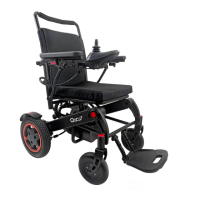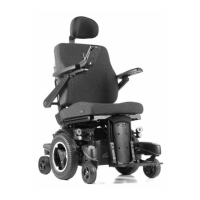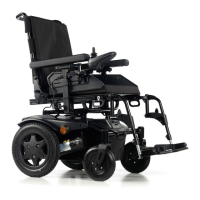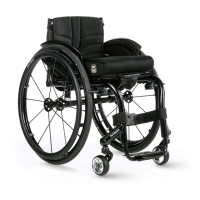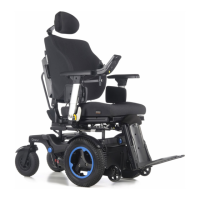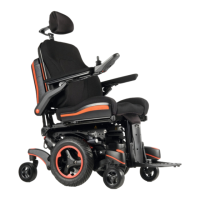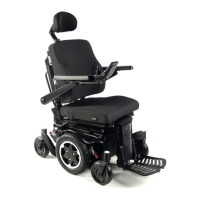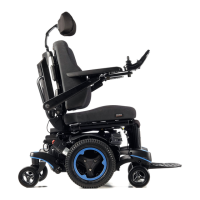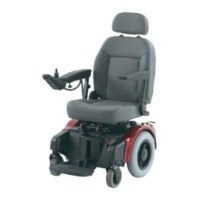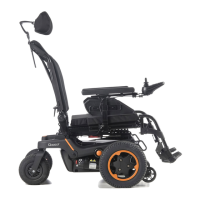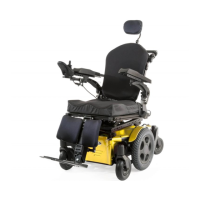
Do you have a question about the Sunrise Medical Quickie Pulse 6 and is the answer not in the manual?
| Brand | Sunrise Medical |
|---|---|
| Model | Quickie Pulse 6 |
| Category | Wheelchair |
| Language | English |
Explains the multimeter's function for powerchair diagnostics and testing.
Details how to use multimeter probes to connect to circuits for accurate readings.
Identifies and explains the function of the multimeter's input ports for various tests.
Describes common symbols found on multimeters for AC, DC, Voltage, Current, Resistance, and Continuity.
Provides essential safety guidelines and recommendations for working on mobility products.
Outlines crucial precautions for handling and working with electric wheelchair batteries safely.
Details safety precautions and operational guidelines for using battery chargers.
Explains Electromagnetic Interference (EMI) and its potential effects on power wheelchairs.
Lists common sources of Electromagnetic Interference (EMI) that can affect wheelchair operation.
Provides proper handling techniques to prevent Electro Static Discharge (ESD) damage to components.
Offers precautions to minimize damage to printed circuit boards from flexing during handling.
Details hazards associated with mishandled batteries, including toxicity and flammability.
Explains factors affecting battery performance and methods for diagnosing battery health.
Outlines procedures and guidelines for servicing and replacing deep-cycle batteries in wheelchairs.
Differentiates between battery types and specifies the correct type for wheelchair installation.
Provides critical instructions for correctly installing batteries to prevent system damage.
Describes the LED battery gauge and its use in indicating charge level and fault codes.
Identifies and explains the function of the On/Off, Horn, and Speed/Profile control buttons.
Details the 4-pin joystick connector pinout and its associated signals.
Explains the charger port and motor plug port connections on the VR2 controller.
Describes the function of the On/Off, Horn, and Speed/Profile control buttons for the R-NET controller.
Explains the operation of the On/Off, Horn, and Speed/Profile controls on the R-NET controller with display.
Details the pin configurations for the R-NET joystick, charger, and motor connectors.
Illustrates the main wiring configuration for VR2 systems, including single and dual actuator setups.
Shows the main wiring diagrams for R-NET systems, covering single and dual actuator configurations.
Depicts the combined wiring diagrams for VR2 and R-NET systems on PLS6A/PLS6B models.
Provides wiring diagrams specifically for the actuator systems (3-Axis, Drive Only, etc.).
Illustrates how to connect the VR2 dual attendant system for proper joystick module interaction.
Lists the essential tools required for performing various maintenance and repair tasks.
Guides on testing battery voltage at the VR2 Bus plug and controller for power issues.
Details how to test the battery wire harness polarity, battery fuse, and circuit breaker.
Procedure for checking the main harness if other troubleshooting steps do not resolve power issues.
Explains the meaning of the Maximum Speed Indicator when it ripples or flashes.
Interprets the various states of the battery gauge LEDs (steady, slow flash, rapid flash).
Troubleshooting steps for the 'One Bar' diagnostic code, indicating low battery voltage.
Diagnosing the 'Two Bars' code related to a disconnected or faulty left motor.
Troubleshooting for 'Three Bars' code, indicating a wiring issue with the left motor.
Steps to diagnose the 'Four Bars' code, signifying a disconnected right motor.
Troubleshooting 'Five Bars' code, related to wiring problems with the right motor.
Explains diagnostic codes 'Six Bars' (Charger), 'Seven Bars' (Joystick), and 'Eight Bars' (Control System).
Details troubleshooting for 'Nine Bars' (Brake Trip) and 'Ten Bars' (High Battery Voltage).
Guides on troubleshooting the R-Net system when the power chair fails to turn on.
Verifies buss cable mating, circuit breaker status, and power connector voltage.
Checks battery voltage at connectors, continuity of fusible links, and circuit breaker.
Explains how faults are displayed on the R-Net hand control or Omni and identifies fault modules.
Provides examples for isolating R-Net fault codes like 'M2 Brake Error' and 'Motor Disconnected'.
Troubleshoots issues where the power chair does not drive at full speed or in creep speed when tilted.
Guides on diagnosing and resolving faults where the tilt function does not operate correctly.
Details methods for testing battery voltage and load capacity to diagnose power issues.
Inspects motor gearbox output shafts for grease leaks and checks the gearbox release lever.
Guides on inspecting brush assemblies, springs, and motor commutators for wear and overheating.
Details inspecting motor connectors for overheating and measuring park brake/motor resistance.
Step-by-step instructions for safely removing batteries from the power chair base.
Procedures for removing the motor and gearbox assembly, including wheel and bolt detachment.
Details motor removal for specific serial number ranges (PLS-101919, PLS6A/PLS6B).
Guides on how to remove the power chair's control module by disconnecting connectors and screws.
Instructions for removing the shock absorber assembly from the power chair base.
Procedures for removing front and rear caster arm assemblies, including braces and couplers.
Steps to remove the caster fork from the caster arm assembly, including nut and bearing considerations.
Details the removal of the tilt actuator and micro-switch assembly used for creep speed.
Guides on adjusting the seat and back width of the seating system for user comfort.
Provides instructions for adjusting the legrest height and position using specific tools.
Details how to adjust the back-rest angle to one of four possible settings using bolts and nuts.
Explains how to operate powered elevating or articulating legrests using VR2/R-Net controls.

